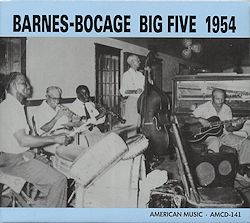
BUY NOW Jazzology |
BARNES-BOCAGE BIG FIVE 1954 |
1. When I Grow Too Old to Dream
2. Rat’s Blues
3. When My Sugar Walks down the Street
4. Sheik of Araby
5. Haltin’ the Blues
6. Toot Toot Tootsie (Goodbye)
7. I’m Gonna Sit Right Down and Write Myself a Letter
8. Holler Blues
9. My Blue Heaven
10. Down in Honky Tonk Town
11. Mama Inez
12. Sheik of Araby (alt. 1)
13. I Can’t Dance (1)
14. I Can’t Dance (2)
15. I’m Gonna Sit Right down and Write Myself a Letter (alt. 1)
16. Down in Honky Tonk Town (alt. 1)
17. Toot Toot Tootsie (Goodbye) (alt. 1)
18. When My Sugar Walks down the Street (alt. 1)
19. Down in Honky Tonk Town (alt. 2)
Personnel:
Emilé Barnes – Clarinet
Peter Bocage – Trumpet
Homer Eugene – Guitar
Eddie Dawson – Bass
Albert Jiles – Drums
Recorded at the San Jacinto Hall, New Orleans, on Sept. 9, 1954.
The names of Peter Bocage and Emilé Barnes are not as well known as those of others who figured more prominently in the New Orleans jazz revival of the 40s through the 60s,.such as Bunk Johnson, George Lewis, Kid Ory, et al. Theirs was a different kind of jazz, one which was driving, which was “hot,” while Bocage, especially, and Barnes opted for a more restrained—but no less passionate—approach.
Bocage, a Creole, leaned as did many other Creoles toward the “downtown” style rather than the “uptown” one of Bunk Johnson, George Lewis, and the others. Barnes, while not a Creole, still complemented Bocage perfectly, as we can hear on this CD. This combo plays music strictly for dancing, which means that it is mainly ensemble playing, the one playing lead always keeping the melody to the fore. Bocage’s playing is largely devoid of vibrato, and he is content to play a lead which stays close to the melody and does not rely on much improvisation, the others being left to provide that. His playing is never loud but is marked with a quiet intensity.
Barnes’ playing has a blues tinge to it and a warm, soft vibrato, particularly when he is playing in the lower register. But he is not averse to the other registers, soaring from one to another effortlessly. He weaves all around the trumpet lead, playing nice obbligatos and counterpoint to Bocage, taking the lead and soloing himself here and there.
The two-man front line is well supported by the rhythm section, Dawson’s bass being quite solid, Jiles’ drumming never obtrusive, with judicious use of tom toms as well as the rest of the traps. Eugene’s guitar playing is very interesting on several counts. First, it is an electric, amplified guitar, which is very unusual in traditional jazz bands of that time (the 1950s) and even today. Second, while he can lay down fine chording support to the front line, he plays quite a bit of single string, especially when he takes the lead and improvises. It is all very tasteful and “works” with what the group is doing.
The repertoire here contains a good number of standards, with only a couple of improvised blues (Rat’s Blues and Haltin’ the Blues and perhaps Holler Blues with its quotes from Tin Roof Blues and Whoopin’ Blues). The New Orleans bands played essentially for dancers, to whom these old favorites, coupled with their variety—foxtrots, fast and slow, a habañera (only the waltz is missing)— would be most appealing, all of them being taken at quite “danceable” tempos, although there is slight tendency now and again to let the tempo creep up a little (e.g., Down in Honky Tonk Town orI Can’t Dance) or vacillate a bit (e.g.,Haltin’ the Blues or I’m Gonna Sit Right down and Write Myself a Letter). These tempo variations, however, are not so pronounced as to be really noticeable, and I would doubt that dancers would detect them since they are not glaring discrepancies. And there were dancers present at this recording, the decision being made—and it was a good one—to open up the doors and admit anyone passing by who cared to come in, especially to dance. Having folks on the dance floor energizes the band, as any musician will aver, and brings out the best in the musicians.
This CD presents over an hour of laid back, happy music that will not deafen the listener. It might encourage one to rise up and take a turn or two around the floor, as we can hear the folks doing in the background of this CD. While this is not the first time the contents of the CD have been issued, there having been a previous issue on American Music (AMCD-84), this one has the benefit of the session’s tracks being remastered. The result is a very entertaining album, and I would join with executive producer Lars Edegran when he says, “It is one of our favorite sessions from that period.”
Bert Thompson